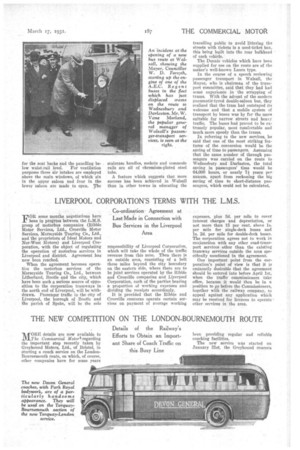Operating Aspects
Page 130

Page 131

If you've noticed an error in this article please click here to report it so we can fix it.
of Passenger Transport MUNICIPAL bus services at Walsall are growing apace and, during the past financial year, the corporation has added 18 vehicles to its fleet, which now comprises 95 machines. The bus undertaking is one of the most prosperous ,of its kind in the country and with commendable vision the corporation has decided upon the ultimate supersession of all the train services, either by the use of petrol buses or by trolleybuses.
The undertaking has, during the past five years, contributed £33,000 to the relief of the rates. The fleet is entirely
• Double-saloon Buses Supersede Trams on an Important Route, Completing Another Link in the Municipality's Scheme of Discarding Fixed line Transport
modern and consists of pneumatic-tyred drop-frame single-deck and double-saloon vehicles.
The latest route on which trains have been abandoned is that between Walsall, Wednesbury and Darlaston, and less
than a fortnight ago an up-to-date fleet of 16 double-saloon vehicles was commissioned for this service, whilst several vehicles remain to be delivered.
The new development is especially noteworthy by reason of the fact that 7t marks the passing of the last surviving section of the one-time extensive network of tramways in the Black Country : in fact, 30 years of use are bound up in the route just abandoned.
The opening ceremony in connection with the new service was performed by Mr. W. Vane Morland, A.M.I.Mech.E., M.I.A.E., M.Inst.T., the general manager and engineer of the tramway and motor services, and, after being taken along the route, a large number of guests was entertained to a luncheon, Presided over by the Mayor, Councillor W. D. Forsyth. Representatives from adjacent municipal undertakings were present, as were members from the staffs of the Associated Equipment Co., Ltd., and Dennis Brothers, Ltd., which, between them, have supplied the vehicles for the new services.
The A.E.O. Regent buses embody the ST-type bodies, in the design of which straight-np staircases are incorporated. The Vehicles each seat 48 passengerS,"21 in the lower saloon and 27 in the upper saloon and .have a wide circulating-area on the conductor's platform whidh is common to all bodies of this pattern. The seats are upholstered in hand-buffed leather, and seratehproof Rexine is used
for the seat backs and the panelling be low waist-rail level. For ventilation purposes three air intakes are employed above the main windows, of which six in the upper saloon and four in the lower saloon are made to open. The staircase handles, sockets and commode rails are all of chromium-plated steel.
tube. .
A feature which suggests that more success has been achieved in .Walsall than in other towns in educating the travelling public to avoid littering the streets with tickets is a used-ticket box, this being built into the rear bulkhead of each vehicle.
The Dennis vehicles which have been supplied for use on the route are of the maker's well-known Lance type.
In the course of a speech reviewing passenger transport in Walsall, the Mayor, who is chairman of the transport committee, said that they had had some experience in the scrapping of trams. With the advent of the modern pneumatic-tyred double-saloon bus, they realized that the tram had outstayed its welcome and that a mobile system of transport by buses was by far the more suitable for narrow streets and heavy traffic. The buses had proved to be extremely popular, most comforthble and much more speedy than the trams.
In referring to the new services, he said that one of the most striking features of the conversion would be the saving of time to passengers. Assuming that the same number of through passengers was carried on the route to Wednesbury and Darlaston, the total saving in passengers' time would be 64,000 hours, or nearly 74years per annum, apart from reckoning the big saving of time to short-distance passengers, which could not be calculated.
























































































































































































